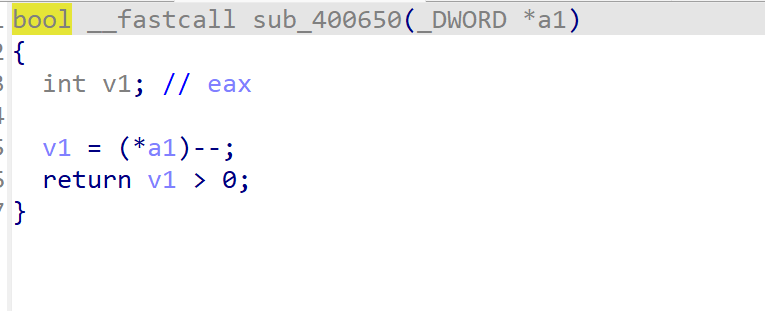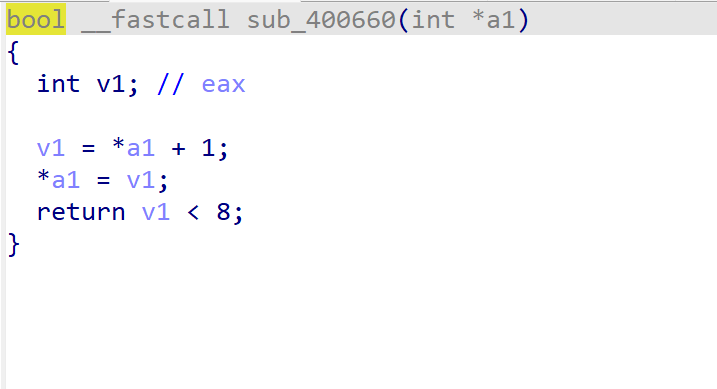攻防世界 - maze
查壳,64位elf,无壳。

进入main函数。

伪代码:
__int64 __fastcall main(int a1, char **a2, char **a3)
{
__int64 v3; // rbx
int v4; // eax
bool v5; // bp
bool v6; // al
const char *v7; // rdi
int v9; // [rsp+0h] [rbp-28h] BYREF
int v10[9]; // [rsp+4h] [rbp-24h] BYREF
v10[0] = 0;
v9 = 0;
puts("Input flag:");
scanf("%s", &s1);
if ( strlen(&s1) != 24 || strncmp(&s1, "nctf{", 5uLL) || *(&byte_6010BF + 24) != 125 )
{
LABEL_22:
puts("Wrong flag!");
exit(-1);
}
v3 = 5LL;
if ( strlen(&s1) - 1 > 5 )
{
while ( 1 )
{
v4 = *(&s1 + v3);
v5 = 0;
if ( v4 > 78 )
{
if ( (unsigned __int8)v4 == 79 )
{
v6 = sub_400650(v10);
goto LABEL_14;
}
if ( (unsigned __int8)v4 == 111 )
{
v6 = sub_400660(v10);
goto LABEL_14;
}
}
else
{
if ( (unsigned __int8)v4 == 46 )
{
v6 = sub_400670(&v9);
goto LABEL_14;
}
if ( (unsigned __int8)v4 == 48 )
{
v6 = sub_400680(&v9);
LABEL_14:
v5 = v6;
}
}
if ( !(unsigned __int8)sub_400690((__int64)asc_601060, v10[0], v9) )
goto LABEL_22;
if ( ++v3 >= strlen(&s1) - 1 )
{
if ( v5 )
break;
LABEL_20:
v7 = "Wrong flag!";
goto LABEL_21;
}
}
}
if ( asc_601060[8 * v9 + v10[0]] != 35 )
goto LABEL_20;
v7 = "Congratulations!";
LABEL_21:
puts(v7);
return 0LL;
}
观察第一段,可以发现flag形式为nctf{开头,长度为24,结尾为}的字符串。

继续阅读,发现程序遍历了字符串{}以内的内容,且当当前位置为O,o,.,0时进入不同的子程序。而当循环结束,最后一次执行子程序返回值不为0时正常跳出循环,否则报错。


然后是四个操作子函数的内容。
sub_400650是自减v10,返回值判断v10是否大于0。

sub_400660是自增v10,返回值判断v10是否小于8

sub_406670和sub_406680和上面两个函数是相同的,只是操作数变成了v9。
对于sub_400690,我们阅读子程序


发现其效果时判断asc_601060[8*v9+v10]是否等于空格或#号,若均不是则报错。

循环外的这段代码判断asc_601060[8*v9+v10]是否等于#号,若不是则报错

因此,在循环过程中 $8 * v9 + v10$ 的所有合法取值为$0,1,9,10,11,13,14,19,21,26,27,29,33,34,36,37,38,42,46,50,51,52,53,54$,而最终要求$8*v9+v10 == 36$,且约束$0<v9<8,0<v10<8$,因此可以猜测$v9=4, v10=44$,
在以上取值中构造出合法序列nctf{o0oo00O000oooo..OO}(过程可以通过调试辅助进行)

获得flag:nctf{o0oo00O000oooo..OO}
复盘发现,这个问题其实是一个迷宫问题:
题目给出的asc_601060是一个8*8的迷宫,我们输入的应该是’.’,‘0’,‘o’,‘O’,并以此来确定上下左右移动

